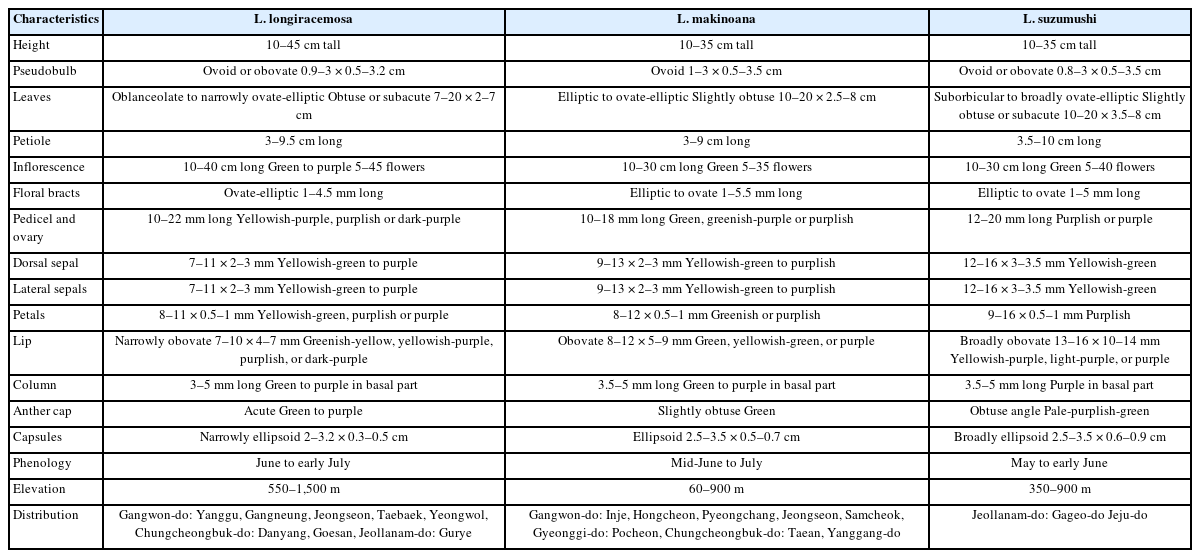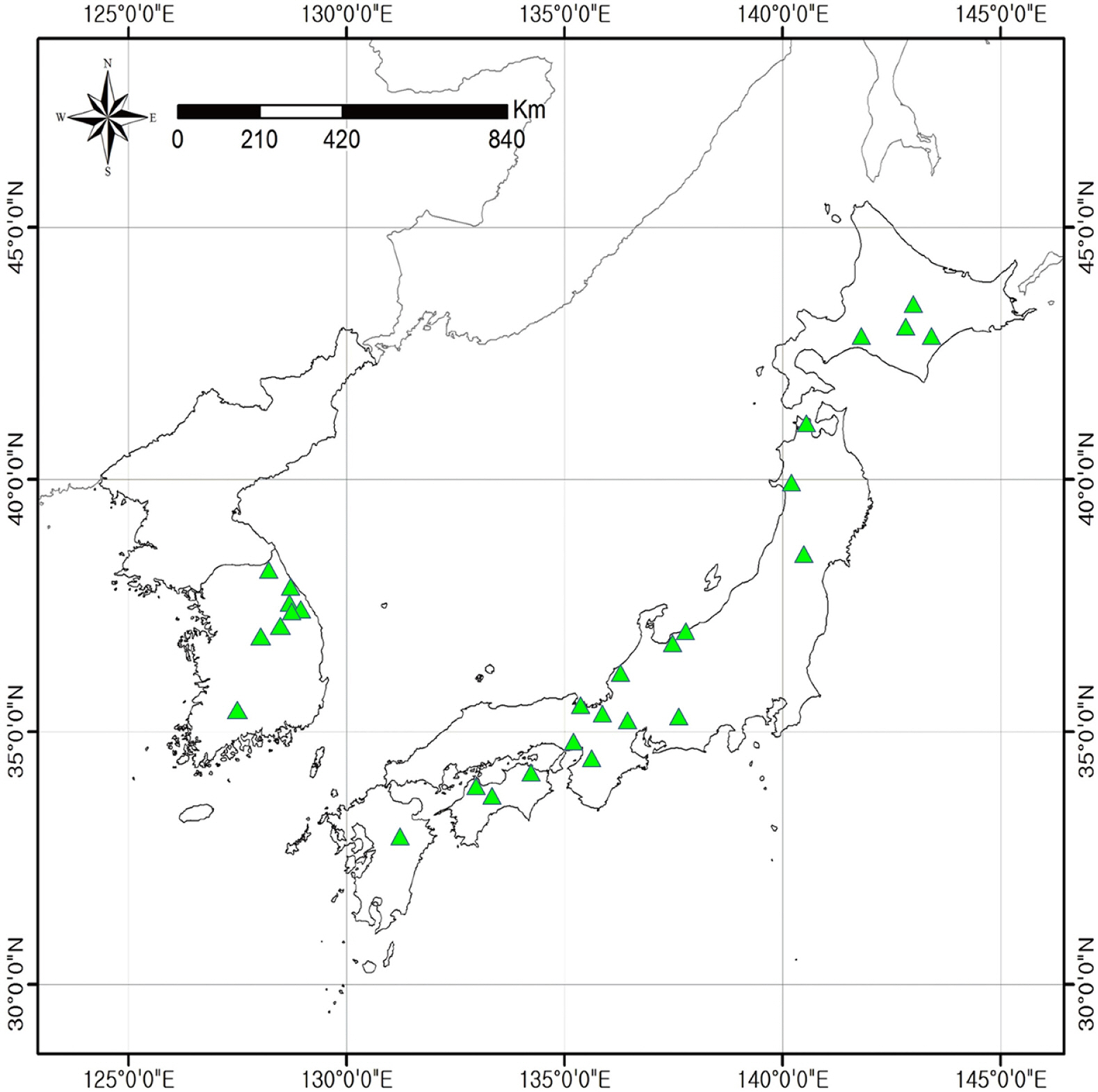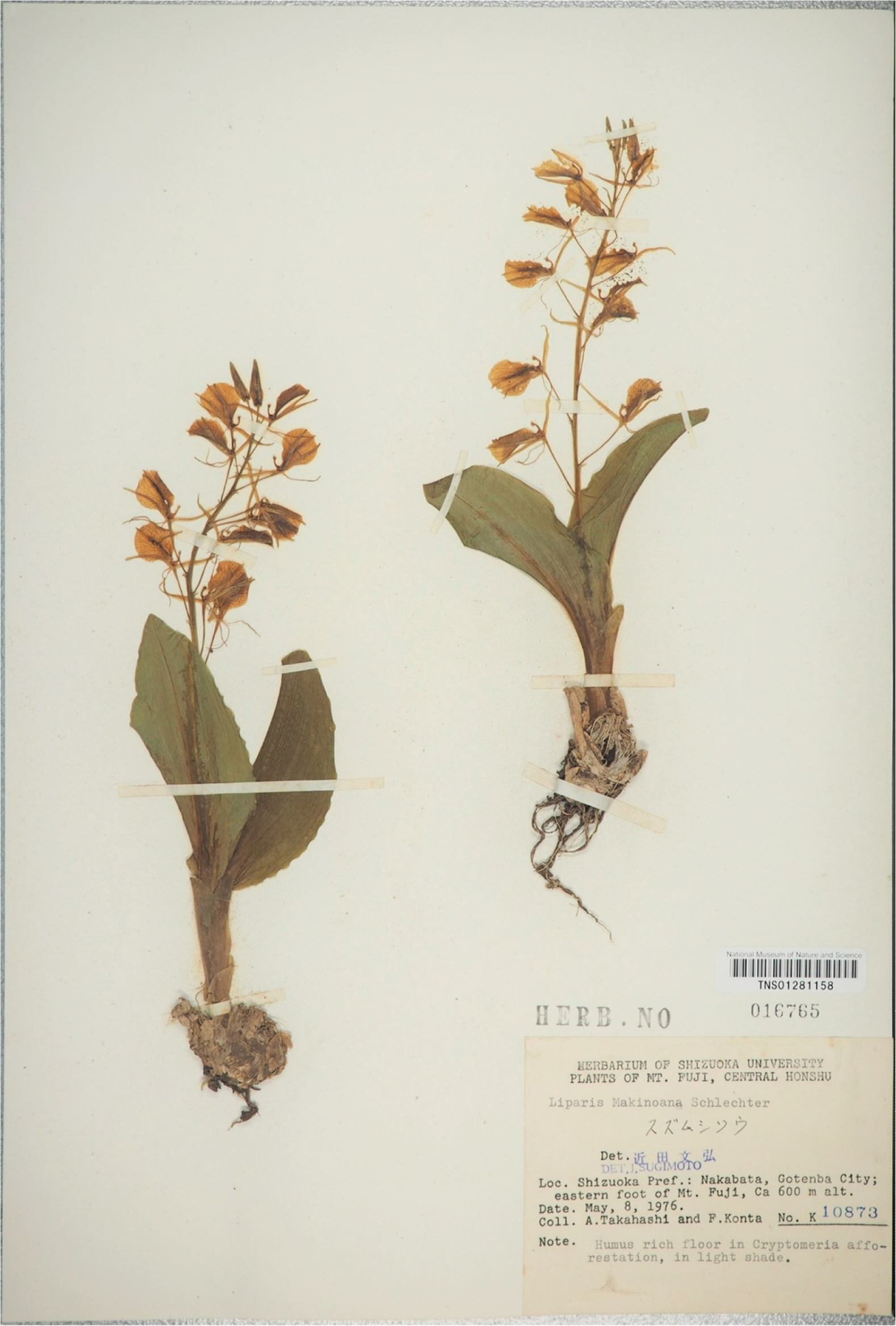Taxonomic revision of the Liparis makinoana complex (Orchidaceae; Epidendroideae; Malaxidae) in Korea
Article information
Abstract
On the Korean Peninsula, eleven species of the genus Liparis (Orchidaceae) have been recorded, and three species are presumed to belong to the L. makinoana complex. These are L. koreana, L. japonica, and L. makinoana. Liparis japonica and L. makinoana are distributed in South Korea, but the distribution of L. koreana has not been confirmed. Liparis japonica and L. makinoana are morphologically very similar, making it difficult to classify them. Recently, L. japonica and L. makinoana in Japan were reclassified into three species. One of them is an amended species of L. makinoana, and the other two species were described as new species, specifically L. longiracemosa and L. suzumushi. It was confirmed that the three species are distributed in South Korea. Here, we provide a distribution map, photographs of the three new species, and a comparison of their morphological characteristics.
INTRODUCTION
Liparis Richard (1817: Orchidaceae) belongs to tribe Malaxideae under the subfamily Epidendroideae and is among the largest genera of Orchidaceae. There are approximately 320 species of this genus, widely distributed in tropical and temperate regions of the world (Chen et al., 2009). The section Liparis, one of the 19 sections of the genus Liparis (Garay and Romero-Gonzalez, 1999), has various morphologies and characteristics that are difficult to distinguish. Liparis includes terrestrial, lithophytic, or epiphytic rhizomatous herbs (Pridgeon et al., 2005; Chen et al., 2009). Their pseudobulbs are ovate, and they have 1 or 2 deciduous, usually ovate-elliptical leaves, with a flower structure consisting of 3 sepals, 2 petals, a lip, a column and anther cap, the absence of a projection at the lip base, and a beaked or apiculate anther cap. They generally form species complexes with multiple morphological characteristics; therefore, complex formations of these characterized species present difficulties when determining taxonomic treatments (Yukawa, 2015; Tsutsumi et al., 2019).
In Korea, eleven species have been reported in the genus Liparis: L. auriculata Blume ex Miq.; L. fujisanensis F. Maek. ex Konta & S. Matsumoto; L. japonica (Miq.) Maxim.; L. koreana (Nakai) Nakai; L. koreojaponica Tsutsumi, T. Yukawa, N. S. Lee, C. S. Lee & M. Kato; L. krameri Franch. & Sav.; L. kumokiri F. Maek; L. makinoana Schltr.; L. nervosa (Thunb.) Lindl.; L. pterosepala N. S. Lee, C. S. Lee & K. S. Lee; and L. yongnoana N. S. Lee, C. S. Lee & K. S. Lee (National Institute of Biological Resources, 2019; Korea National Arboretum, 2021). L. koreana, L. japonica, and L. makinoana constitute the L. makinoana complex. Given their similar morphologies and growth environments, it has been difficult to classify them as distinct species. In particular, L. koreana has been recorded as being distributed in Korea and Japan (Chung, 1957, 1965; Lee, 1980; Kim and Kim 1986; Lee 1996a, 1996b; Kim and Lee 1997; Lee, 2002; Tsutsumi et al., 2007; Lee, 2011; Nakajima, 2012); however, it has now been re-identified to be distributed only in Korea (Tsutsumi et al., 2008). Liparis koreana was originally described as L. makinoana var. koreana Nakai based on specimens collected from Byeokdong, Pyeongbuk Province in North Korea, but its distribution in South Korea has not yet been confirmed.
Other taxa in the L. makinoana complex include L. japonica and L. makinoana, which are morphologically very similar to each other and are thus often confused in the nomenclature. The lack of data on protologues and the uncertainty of their taxonomic position(s) have raised many questions. In particular, the protologues of L. japonica were Malaxis monophyllos (L.) Sw., and the type specimen could not be referenced. Furthermore, the most current specimen of L. makinoana was destroyed in the Second World War. For this reason, the type specimen of L. makinoana was previously unknown, adding confusion to the classification of the original L. makinoana (Yukawa and Ohba, 1995; Tsutsumi and Yukawa, 2008; Efimov, 2010). Fortunately, specimens collected in 1861 from Hokkaido, Japan, were eventually designated as neotypes of L. makinoana (Efimov, 2010). As the neotype of L. makinoana is designated, recently, taxonomic studies of these species have been carried out using primarily Japanese materials (Tsutsumi et al., 2007; Tsutsumi and Yukawa, 2008; Tsutsumi et al., 2019). As a result, amendment species of L. makinoana based on the original description of L. makinoana were proposed. Two new species (Liparis longiracemosa Tsutsumi, T. Yukawa et M. Kato and Liparis suzumushi Tsutsumi, T. Yukawa & M. Kato) were described (Tsutsumi et al., 2007; Tsutsumi and Yukawa, 2008; Tsutsumi et al., 2019).
Accordingly, we recognize that the reclassification and investigation of the distribution of the L. makinoana complex taxa native to Korea are essential by studying them alongside specimens designated as neotypes of L. makinoana.
MATERIALS AND METHODS
We examined the original type specimens of L. longiracemosa, L. makinoana, and L. suzumushi, which were deposited in the Herbarium of the National Museum of Natural Science (TNS) and the Komarov Botanical Institute of the Russian Academy of Sciences (LE). To understand the morphological characteristics of the three species, the original descriptions were analyzed, and specimens collected from all over Korea through field investigations were thoroughly reviewed. A distribution map was created with data from field investigations and dried specimens deposited in the Korea National Herbarium (KH). Distribution data for Korea and Japan (Tsutsumi et al., 2019) were also compared. All measurements of the species L. makinoana, L. suzumushi, and L. longiracemosa were made from fresh materials during the field observations, and the vegetative and reproductive structural characteristics of each species were analyzed. Morphological characteristics were measured using digital Vernier calipers based on data derived from field notes, during flowering and fruiting, and comparison tables and photographs (Figs. 1, 2, Table 1) of their morphological characteristics were obtained. The voucher specimens were deposited in the KH.
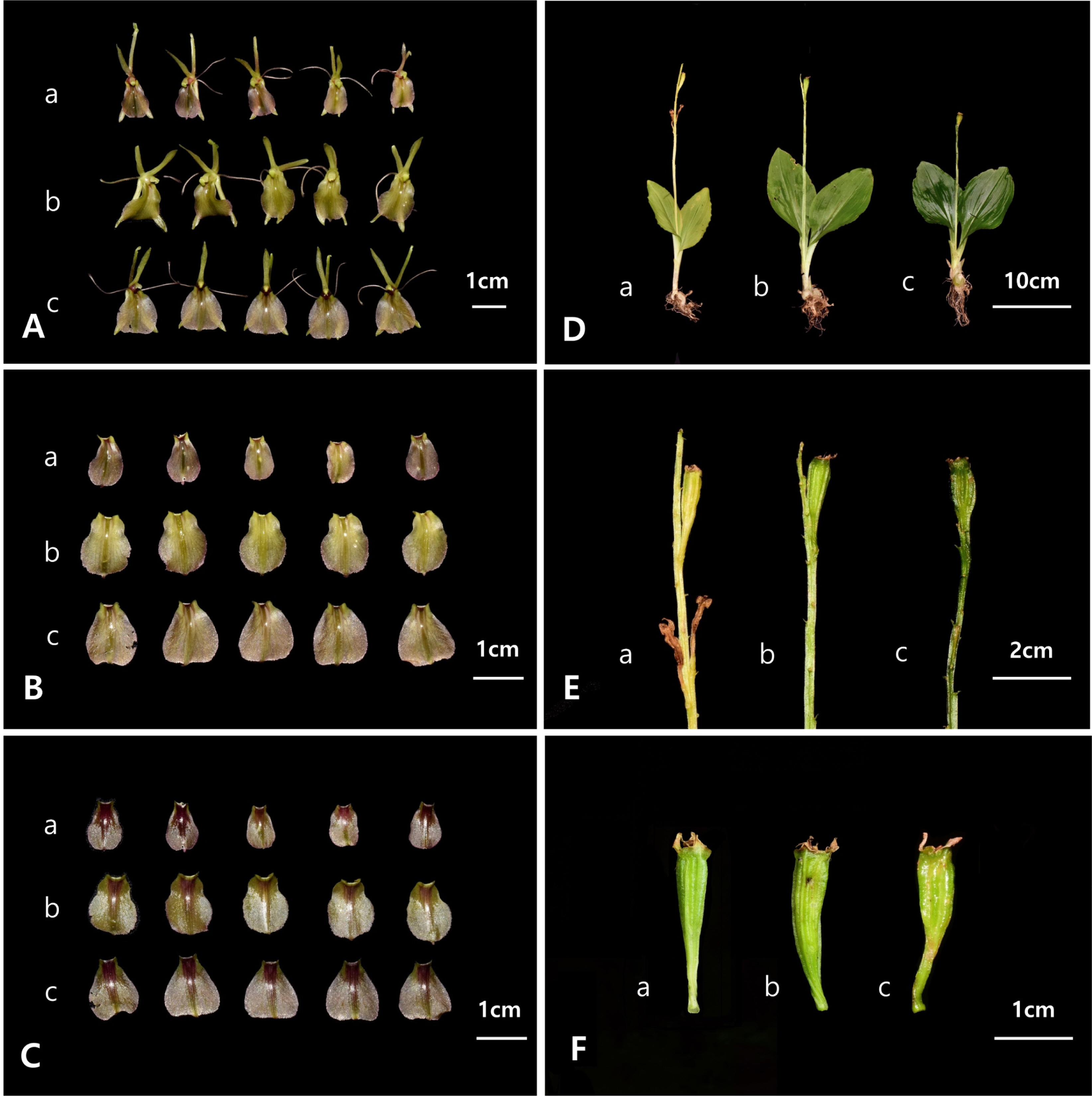
Comparison of the morphological characteristics of the Liparis makinoana complex in Korea. A. Front view of flowers of various sizes and colors. B. Front view of lips of various sizes and colors. C. Rear view of lips of various sizes and colors. D. Fruiting plants. E. Capsules attached to inflorescence axis. F. Capsules. a, L. longiracemosa; b, L. makinoana; c, L. suzumushi.

Side view of anther cap types of the Liparis makinoana complex. A. Liparis longiracemosa. B. Liparis makinoana. C. Liparis suzumushi.
TAXONOMIC TREATMENT
-
Liparis longiracemosa Tsutsumi, T. Yukawa & M. Kato, Bull. Natl. Mus. Nat. Sci., Tokyo, B. 45: 114, 2019.—TYPE: JAPAN. Akita Pref., Anitotorinai, Kitaakita-shi, 530 m elev., 23 Jun 2008, C. Tsutsumi, K. Miyoshi, M. Taguchi & Kon CT1608 (holotype: TNS 778816, Photo!) (Figs. 3–5).
Terrestrial herbs, 10–45 cm tall. Roots ca. 1 mm in diam. Pseudobulbs aggregated, ovoid or obovate, 0.9–3.0 × 0.5– 3.2 cm in diam, enclosed by 2 or 3 membranaceous sheaths; sheaths ovate-lanceolate, 1.2–3.0 cm long, short subacute at apex. Leaves 2; petiole base sheathing, enclosing peduncle, winged, 3.0–9.5 cm long; blades green, oblanceolate to narrowly ovate-elliptic, 7–20 × 2–7 cm, conduplicate, plicate, apex obtuse or subacute, margin entire, occasionally undulate, both surfaces glabrous. Inflorescence terminal, racemose, 10– 40 cm long; scape glabrous, ca. 8–25 cm long, ca. 2–4 mm in diam., slightly compressed cylindric, narrow wings on either side, 3(4)-ridged, green to purple, laxly bearing 5–45 flowers; floral bracts ovate-elliptic, triangular, 1.0–4.5 mm long, acute, green. Pedicel and ovary twisted at base, ca. 10– 22 mm long, yellowish-green, yellowish-purple, purplish or dark-purple. Flowers yellowish-green, pale-green, pale purplishbrown, or dark-purple, widely open, tinged yellowish or purple especially in middle of lip; dorsal sepal linear-lanceolate, 7– 11 × 2–3 mm, apex subacute, slightly revolute, erect or sometimes recurved at upper part, yellowish-green to purple; lateral sepals yellowish-green to purple, obliquely ovate or obliquely lanceolate, 7–11 × 2–3 mm, apex subacute, margin sometimes revolute; petals yellowish-green, purplish or purple, falcate, 8–11 × 0.5–1.0 mm, linear, apex obtuse, margin strongly revolute, pendulous, sometimes slightly twisted, positioned lower than lateral sepals; lip porrect, narrowly obovate, 7–10 × 4–7 mm, narrowed toward base, apex roundly truncate and mucronate, minutely apiculate in the middle of the apex, clawed, strongly recurved near base, obtuse or truncate, apiculate at apex, greenish-yellow, yellowish-purple, purplish, or dark-purple. Column greenish to purple-tinged, incurved, with rounded wings at apex, 3– 5 mm long, very dilated at base, pale-green to green on ventral surface, green to purple in basal part; anther cap ovate, 2-celled, cells surrounded by whitish rim, with beaked in front, ligule-like caudate, slightly curved or abrupt, obliquely subrounded, becoming narrow and acute at the end part, green to purple; pollinia 4 in 2 pairs, ovoid, deltoid, waxy, yellow. Capsules narrowly ellipsoid, 2.0–3.2 × 0.3–0.5 cm, stalk 5–10 mm long.
Distribution: Korea. Gangwon-do: Yanggu, Gangneung (Mt. Seokbyeongsan), Jeongseon (Mt. Hambaeksan), Taebaek (Mt. Taebaeksan), Yeongwol. Chungcheongbuk-do: Danyang (Mt. Sobaeksan), Goesan (Mt. Imanbong). Jeollanam-do: Gurye (Mt. Jirisan). Japan. Hokkaido, Honshu, Shikoku, Kyushu (Fig. 6).
Ecology: Liparis longiracemosa grows in semi-open, somewhat wet places in deciduous or mixed conifer forests, or humid environments on mountain ridges.
Phenology: Flowering early June to mid-July.
Vernacular names: Ki-da-li-nan-cho (키다리난초).
Notes: In Korea, L. japonica and L. makinoana were mistakenly known as inland and Jeju Island types, respectively, with the scientific name L. japonica being used for the inland type and the scientific name L. makinoana being mainly used for the Jeju type. However, although the two types were native to the inland, these two scientific names were sometimes used interchangeably, as it was not confirmed whether they were L. japonica or L. makinoana. L. japonica was clearly confirmed to be a synonym for Malaxis monophyllos (L.) Sw. by Tsutsumi et al. (2019), and the two inland species in Korea were reclassified as separate species. One type was reconfirmed as an amendment species of L. makinoana based on the original description of L. makinoana, and the other type, L. longiracemosa, was a new species and was described as an unidentified species in Korea (Figs. 3–5).
The combined use of the scientific names of L. longiracemosa and L. makinoana has long caused much confusion in Korea. Liparis longiracemosa looks similar to L. makinoana but has distinct morphological and distributional differences (Figs. 1, 2, 6, Table 1). Liparis longiracemosa has a peduncle that is about 5 cm longer than that of L. makinoana and a lip that is about 1–2 mm long and thinner (Fig. 2, Table 1). The plant size of Liparis longiracemosa tends to become somewhat smaller as the altitude increases, but the length, width, and shape of the lip remain nearly constant in low-altitude areas, and the rachis has a particularly dark-purple color. Liparis longiracemosa is distributed from north to south along the Baekdu-daegan at 550–1,500 m, while L. makinoana is distributed 60–900 m in the central region from the east to the west (Table 1). This species is mainly distributed in Taebaek and Jeongseon in Gangwon-do, where the Baekdu-daegan passes through, forming several populations, but small populations grow wild in other areas. Tsutsumi et al. (2019) described the distribution in Japan (Hokkaido, Honshu, Shikoku, Kyushu) without mentioning a distribution in Korea. Liparis longiracemosa was clearly identified as a native species distributed in Korea. In addition, a specimen collected by Ohwi in 1935 from Mt. Jirisan, the starting point of the Baekdu-daegan, supports this; it was deposited at the University of Tokyo (TI).
“Ki-da-li-nan-cho” is a name that was previously used for taxa recognized as L. japonica. The meaning of “Ki-da-li” in the local language, like the species epithet of L. longiracemosa, means “a long peduncle,” and “nan-cho” means “orchid.” We propose to continue to use the local name of “Ki-da-li-nan-cho” to avoid confusion between the scientific and local names.
Specimens examined: KOREA. Gangwon-do: Gangneung-si, Okgye-myeon, Sangye-ri, Mt. Seokbyeongsan, 2 Jul 2014, Kim et al. DK2014051, DK2014052, DK2014053 (KH); same locality, Jong-Cheol Yang & Min-Jeong Ju DK2014048, DK2014050 (KH); same locality, 2 Jul 2006, Hyun et al. 701008 (KH); Samcheok-si, Singi-myeon, Daei-ri, Mt. Deokhangsan, 12 Jun 2009, Yang et al. s.n. (KH); Yanggu-gun, Dong-myeon, Wolun-ri, 27 Jun 2015, J.S. Lee ljs15062701 (KH); same locality, 13 Jul 2017, J.S. Lee ljs17071301 (KH); same locality, 19 Jul 2019, J.S. Lee ljs19071901, ljs19071902 (KH); same locality, 13 Jun 2020, J.S. Lee ljs20061301 (KH); same locality, 27 Jun 2020, J.S. Lee ljs20062701 (KH); same locality, 5 Jun 2021, J.S. Lee ljs21060501 (KH); same locality, 7 Jul 2021, J.S. Lee ljs21070701 (KH); Yeongwol-gun, Sangdong-eup, Gurae-ri, 14 Jun 2020, J.S. Lee ljs20061402 (KH); same locality, 13 Jul 2021, J.S. Lee ljs21071301, ljs21071302 (KH); same locality, 1 Aug 2021, J.S. Lee ljs21080103 (KH); same locality, 12 Jun 2022, J.S. Lee ljs22061201 (KH); same locality, 25 Jun 2022, J.S. Lee ljs22062502 (KH); Jeongseon-gun, Mt. Geumdaebong, 14 Jul 2002, J-O Hyun & H-K Park s.n. (KH); Gohan-eup, Gohan-ri, Manhangjae, 14 Jul 2016, J.S. Lee ljs16071401 (KH); Gohan-eup, Gohan-ri, 28 Jun 2020, J.S. Lee ljs20062802 (KH); Gohan-eup, Gohan-ri, Mt. Geumdaebong, 28 Jun 2020, J.S. Lee ljs20062803 (KH); Gohan-eup, Gohan-ri, 27 Jun 2021, J.S. Lee ljs21062701 (KH); same locality, 25 Jul 2021, J.S. Lee ljs21072501 (KH); same locality, 1 Aug 2021, J.S. Lee ljs21080101, ljs21080102 (KH); same locality, 19 Jun 2022, J.S. Lee ljs22061901 (KH); same locality, 26 Jun 2022, J.S. Lee ljs22062601 (KH); Taebaek-si, Mt. Yeonhwasan, 26 Jun 2008, Yoo et al. s.n. (KH); Taebaek-si, Cheoram-dong, Mt. Myeonsan, 27 Jun 2009, Hyun et al. 802005 (2 sheets), 802029, 802033 (KH); same locality, 31 Jun 2009, Hyun et al. s.n. (KH); Jangseongdong, san-79, 6 Jun 2020, J.S. Lee ljs20060601, ljs20060602 (KH); same locality, 14 Jun 2020, J.S. Lee ljs20061401 (KH); same locality, 28 Jun 2020, J.S. Lee ljs20062801 (KH); same locality, 30 May 2021, J.S. Lee ljs21053001 (KH); Dongjeom-dong, Mt. Parkwolsan, 30 May 2021, J.S. Lee ljs21053002 (KH); Jangseong-dong, 4 Jun 2021, J.S. Lee ljs21060401 (KH); same locality, 5 Jun 2022, J.S. Lee ljs22060501 (KH); same locality, 25 Jun 2022, J.S. Lee ljs22062501 (KH); Hyeol-dong, Mt. Taebaeksan, 11 Sep 2022, J.S. Lee ljs22091101 (KH). Chungcheongbuk-do: Goesan-gun, Yeonpung-myeon, Bunji-ri, Mt. Imanbong, 24 Jun 2021, J.S. Lee ljs21062401 (KH); same locality, 2 Jul 2021, J.S. Lee ljs21070201 (KH); Danyang-gun, Daegang-myeon, Sadong-ri, Mt. Sobaeksan, 11 Jul 2021, J.S. Lee ljs21071101 (KH). Jeollanam-do: Jeonnam, Mt. Jirisan, Jun 1935, J. Ohwi 6909 (TI); Gurye-gun, Toji-myeon, Munsu-ri, Mt. Jirisan, 26 Jun 2021, J.S. Lee ljs21062601, ljs21062602 (KH); same locality, 22 Aug 2021, J.S. Lee ljs21082201, ljs21082202 (KH); same locality, 19 Jun 2022, J.S. Lee ljs22061902 (KH).
-
Liparis makinoana Schltr., Repert. Spec. Nov. Regni Veg. Beih. 4: 63, 1919.—TYPE: JAPAN. “insula Jesso, circa Hakodate, Nodafu, in muscosis udis,” 22 Jun or 4 Jul 1861, Dr. Albrecht. (neotype: LE 01016040, Photo!; specimen at left arrow mark). (Figs. 7–9).
Liparis japonica var. makinoana (Schltr.) M. Hiroe, Orchid Flowers 2: 79 (1971).
Terrestrial herbs, 10–35 cm tall. Roots ca. 1 mm in diam. Pseudobulbs aggregated, ovoid, 1–3 × 0.5–3.5 cm, enclosed by 2 or 3 membranaceous sheaths; sheaths ovate-lanceolate, 1–3 cm long, shortly subacute at apex. Leaves 2; petiole base sheathing, enclosing peduncle, winged, 3–9 cm long; blades green, elliptic or ovate-elliptic, slightly obtuse, 10–20 × 2.5– 8 cm, conduplicate, plicate, apex slightly obtuse, margin entire, occasionally undulate, both surfaces glabrous. Inflorescence terminal, racemose, 10–30 cm long; scape slightly slender, relatively long, glabrous, ca. 5–20 cm long, ca. 2.5–4.5 mm in diam., slightly compressed cylindric, narrow or broad wings on either side, 3(4)-ridged, green; laxly bearing 5–35 flowers; floral bracts elliptic to ovate, triangular, 1.0–5.5 mm long, subacute to acute, green. Pedicel and ovary twisted at base, ca. 10–18 mm long, green, greenish-purple, or purplish. Flowers yellowish-green, green, purple, or dark-purple, widely open, green or purple especially in middle of lip; dorsal sepal linear-lanceolate, 9–13 × 2–3 mm, apex subacute, slightly revolute, erect or sometimes recurved, yellowish-green to purplish; lateral sepals yellowish-green to purple, obliquely elliptic or oblong-lanceolate, 9–13 × 2–3 mm, apex subacute, sometimes revolute; petals greenish or purplish, falcate, 8– 12 × 0.5–1.0mm, linear, obtuse, apex slightly revolute, pendulous, sometimes slightly twisted, positioned lower than lateral sepals; lip porrect, obovate, 8–12 × 5–9 mm, narrowed toward base, apex roundly truncate and mucronate, minutely apiculate in the middle of the apex, clawed, strongly recurved near base, green, yellowish-green, or purple. Column green to purple-tinged, incurved, with rounded wings at apex, 3.5– 5.0 mm long, much dilated at base, pale-green to green on ventral surface, green to purple in the basal part; anther cap ovate, 2-celled, cells surrounded by whitish rim, with beaked in front, ligule-like caudate, slightly curved, obliquely rounded, become narrow and slightly obtuse at the end part, green; pollinia 4 in 2 pairs, ovoid, deltoid, waxy, yellow. Capsules ellipsoid, 2.5–3.5 × 0.5–0.7 cm, stalk 3–8 mm long.
Distribution: Korea. Gangwon-do: Inje, Hongcheon, Pyeongchang, Jeongseon, Samcheok. Gyeonggi-do: Pocheon. Chungcheongnam-do: Taean. Yanggang-do: Mt. Baekdu Yalu-river. Japan. Hokkaido, Honshu. China. Jilin, Heilongjiang. Russia. Far East (Fig. 10).
Ecology: Liparis makinoana grows in semi-open deciduous and mixed forests, forest edges, glades.
Phenology: Flowering mid-June to July.
Vernacular names: Na-li-nan-cho (나리난초).
Notes: Liparis makinoana was designated as a neotype based on the protologue, morphology, and molecular studies of the original description, and the prototype of L. makinoana was amended (Efimov, 2010; Tsutsumi et al., 2019). An herbarium sheet (LE 01016040) collected near Hakodate, Hokkaido, Japan, was designated as a neotype of L. makinoana. In Fig. 8, the plant on the left was designated as a type plant of L. makinoana (Tsutsumi et al., 2019), according to Art. 9.17 of the current International Code of Nomenclature for algae, fungi, and plants (Turland et al., 2018). The large plant in the center is L. koreojaponica Tsutsumi, T. Yukawa, N. S. Lee, C. S. Lee et M. Kato, and the small plants on the periphery it is thought to be L. makinoana or L. suzumushi (Tsutsumi et al., 2019), but a detailed examination of these plants is still required.
In Korea, the Jeju type has long been assigned the scientific name of L. makinoana, and it was also recognized as L. longiracemosa, one of two species appearing inland. However, one of the inland types was subsequently reidentified as the original L. makinoana (Figs. 7–9). In terms of its morphological traits, this species has traits between those of L. longiracemosa and L. suzumushi (Table 1). These plants are relatively tall at 10–35 cm. Leaves are elliptic or ovate-elliptic; the leaf margin is entire. The flowers are laxly borne, with 5–35 flowered on the rachis. The lip is obovate, 8–12 × 5–9 mm, and has a green, yellowish-green, or purple color compared to the other two species (Fig. 2B). Liparis makinoana and L. longiracemosa have a similar flowering time of June–July, but L. makinoana has a flowering time two to three weeks later than that of L. longiracemosa. L. makinoana is native to altitudes of 60–900 m. The area with the lowest altitude consisted of coastal hills in Chungcheongnam-do, and the highest area was a mountain forest in Gangwon-do. This species is mainly distributed in the mid-northern region of Korea and is distinct from L. longiracemosa, including in its distribution area (Figs. 6, 10).
As with L. longiracemosa and L. suzumushi, we propose that the familiar “Na-li-nan-cho” should continue to be used. “Na-li-nan-cho” is the original national name for L. makinoana.
Specimens examined: KOREA. Gangwon-do: Samcheok-si, Miro-myeon, Mt. Dutasan, 1 Jul 2007, Hyeon et al. s,n. (KH); Inje-gun, Seohwa-ri, 7 Jul 2021, J.S. Lee ljs21070701 (KH); Jeongseon-gun, Mt. Nomoksan, 31 May 2008, B.U. Oh Nomoksan-080531-006 (2 sheets, KH); Sabuk-eup, 3 Jul 2008, B.U. Oh Nomoksan-080703-124 (3 sheets, KH); Imgyemyeon, 2 Jul 2011, Choi et al. 0801022 (KH); Hwaammyeon, 2 Jul 2011, Lee et al. s.n. (KH); Imgye-myeon, Mt. Gakheesan, 5 Jul 2011, J.M. Jeong & J.H. Im 0601014 (KH); Hwaam-myeon, Hwaam-ri, 11 Jul 2021, J.S. Lee ljs21071101 (KH); same locality, 13 Jul 2021, J.S. Lee ljs21071303 (KH); same locality, 5 Aug 2021, J.S. Lee ljs21080501 (KH); same locality, 26 Jun 2022, J.S. Lee ljs22062601 (KH); Pyeongchanggun, Daehwa-myeon, Daehwa-ri, 27 Jun 2021, J.S. Lee ljs21062702 (KH); same locality, 13 Jul 2021, J.S. Lee ljs21071302 (KH); same locality, 1 Aug 2021, J.S. Lee ljs21080104 (KH); same locality, 26 Jun 2022, J.S. Lee ljs22062602, ljs22062603 (KH); Hongcheon-gun, Naemyeon, Jaun-ri, 2 Jul 2012, J.S. Lee ljs12070201 (KH). Gyeonggi-do: Kwangnung, 4 Jun 1972, s.n. 192 (RSA0049454); Pocheon-si, Soheul-eup, Jikdong-ri, Gwangneung Pyeonghwawon, 29 May 2011, Park et al. ParkSH 110750 (KH). Yanggang-do: Mt. Baekdu Yalu-river, 26 Jun 1897, V.L. Komarov s.n. (LE01003560). Chungcheongnam-do: Taean-gun, Sowon-myeon, 6 Jul 2021, J.S. Lee ljs21070601 (KH).
-
Liparis suzumushi Tsutsumi, T. Yukawa & M. Kato, Bull. Natl. Mus. Nat. Sci., Tokyo, B 45: 109, 2019.—TYPE: JAPAN. Shizuoka: Gotenba, Nakabata, eastern foot of Mt. Fuji, ca. 600 m elev., 8 May 1976, A. Takahashi & F. Konta 10873 (TNS 01281158 Photo!) (Figs. 11–13).
Terrestrial herbs, 10–35 cm tall. Roots ca. 1 mm in diam. Pseudobulbs aggregated, ovoid or obovate, 0.8–3.0 × 0.5–3.5 cm in diam, enclosed by 2 or 3 membranaceous sheaths; sheaths ovate-lanceolate, 1.5–3.0 cm long, shortly subacute at apex. Leaves 2; petiole base sheathed, enclosing peduncle, winged, 3.5–10 cm long, blades green, suborbicular to broadly ovate-elliptic, 10–20 × 3.5–8.0 cm, base subcordate, conduplicate, plicate, apex slightly obtuse to subacute, margin entire, occasionally undulate, both surfaces glabrous. Inflorescence terminal, racemose, 10–30 cm long; scape glabrous, ca. 5–20 cm long, ca. 2.5–4.5 mm in diam., slightly compressed cylindric, narrow or broad wings on either side, 3(4)-ridged, green; laxly bearing 5–40 flowers; floral bracts elliptic to ovate, triangular, 1–5 mm long, subacute to acute, green. Pedicel and ovary twisted at base, ca. 12–20 mm long, purplish or purple. Flowers light-purple, greenish-purple, yellowish-purple, purple, or dark-purple, widely opening, tinged yellowish-green or purple especially in middle of lip; dorsal sepal linear-lanceolate, 12–16 × 3–4 mm, apex subacute, slightly revolute, erect or sometimes recurved at upper part, yellowish-green; lateral sepals yellowish-green, obliquely elliptic or oblong-lanceolate, 12–16 × 3–4 mm, apex subacute, margin sometimes revolute; petals purplish, falcate, 12–16 × 0.5–1.0 mm, linear, apex obtuse, margin strongly revolute, pendulous, sometimes slightly twisted, positioned lower than lateral sepals; lip porrect, broadly obovate, 13–17 × 10–15 mm, narrowed toward base, apex roundly truncate and mucronate, minutely apiculate in the middle of the apex, clawed, strongly recurved near base, yellowish-purple, light-purple, or purple. Column purpletinged, incurved, with rounded wings at apex, 4.5–5.0 mm long, very dilated at base, green to pale-green on ventral surface, purple in basal part; anther cap ovate, 2-celled, cells surrounded by whitish rim, with beaked in front, ligule-like caudate, at right angles curved, obliquely rounded and obtuse angle in end part, pale purplish-green; pollinia 4 in 2 pairs, ovoid, deltoid, waxy, yellow. Capsules broadly ellipsoid, 2.5– 3.5 × 0.6–0.9 cm, stalk 10–15 mm long.
Distribution: Korea (Gageo-do, Jeju-do). Japan (southern Hokkaido, Honshu, Shikoku). Russia (Fig. 14).
Ecology: L. suzumushi grows in semi-open deciduous and mixed forests or in semi-open secondary conifer forests, along forest edges, and in forest glades.
Phenology: Flowering May to early June.
Vernacular names: Je-ju-na-li-nan-cho (제주나리난초).
Notes: Before L. suzumushi was described as a new species (Tsutsumi et al. 2019) (Figs. 11–13), it was long recognized as L. makinoana. This species has been confirmed to be distributed on Jeju Island and Gageo Island in Korea and to grow wild in grasslands and forest slopes at altitudes of 350– 900 m (Fig. 14). The flowering time is May–June in early summer for L. suzumushi, while L. longiracemosa and L. makinoana flower in June–July; therefore, the flowering time of L. suzumushi is about a month earlier. The leaves of L. suzumushi are suborbicular, ovate, or broadly ovate-elliptic; the base is round, with the surface of the leaves appearing slightly wrinkled with somewhat prominent veins. The lip is broadly obovate, 13–16 × 10–14 mm, broadly dilated on both ends below the margins; the end of the anther cap is at a right angle, curved, with an obliquely rounded and obtuse angle at the end part, with the beak being rectangular. Liparis suzumushi is clearly distinguished from L. longiracemosa and L. makinoana by the size of the lip and the morphology of the anther cap (Figs. 1, 2, Table 1).
The local name is most commonly used in Jeju-do; therefore, we propose the use of “Je-ju-na-li-nan-cho,” which is a combination of the regional name “Jeju” and the long-used name “Na-li-nan-cho” (Lee, 2002).
Specimens examined: KOREA. Jeju-do: Jeju-do, 3 Aug 1955, Lee Yong No s.n. (MICH1313824); Bukjeju-gun, Gujwa-eup, Bijarim, 19 Jul 2005, E.S. Jeon ESJeon 51829 (KH); Seogwipo-si, Namwon-eup, Sumang-ri, 6 May 2013, J.S. Lee ljs13050601 (KH); Sinrye-ri, 14 May 2020, J.S. Lee ljs20051401 (KH); same locality, 23 May 2020, J.S. Lee ljs20052301 (KH); Sumang-ri, 6 May 2021, J.S. Lee ljs21050601 (KH); Hannam-ri, 27 May 2021, J.S. Lee ljs21052701 (KH); Sinrye-ri, 27 May 2021, J.S. Lee ljs21052702, ljs21052703, ljs21052704, ljs21052705 (KH); Seoseong-ro, 7 May 2022, J.S. Lee ljs22050701 (KH); Daepo-dong, 22 May 2022, J.S. Lee ljs220502201, ljs220502202 (KH); Sinrye-ri, 22 May 2022, J.S. Lee ljs220502206 (KH); Seoseong-ro, 22 May 2022, J.S. Lee ljs220502207 (KH); Pyoseon-myeon, Gasi-ri, 22 May 2022, J.S. Lee ljs220502208 (KH); Sinrye-ri, 6 Jun 2022, J.S. Lee ljs220600601, ljs220600602, ljs220600603 (KH); Jeju-si, Ara-dong, 30 Aug 1947, Chung In-Cho 4070 (MICH1652377); Aewol-eup, Eoeum-ri, 31 Jun 2019, J.S. Lee ljs19063101 (KH); same locality, 13 May 2020, J.S. Lee ljs20051301, ljs20051302 (KH); same locality, 24 May 2020, J.S. Lee ljs20052401, ljs20052402, ljs20052403 (KH); same locality, 10 Jun 2020, J.S. Lee ljs20061001, ljs20061002 (KH); same locality, 6 May 2021, J.S. Lee ljs21050602 (KH); same locality, 28 May 2021, J.S. Lee ljs21052801, ljs21052802, ljs21052803 (KH); same locality, 13 Aug 2021, J.S. Lee ljs21081301, ljs21081302 (KH); same locality, 22 May 2022, J.S. Lee ljs22052203, ljs22052204, ljs22052205 (KH). Jeollanam-do: Shinan-gun, Heuksan-myeon, Gageo-do, 29 Jun 2016, J.S. Lee ljs16062901 (KH).
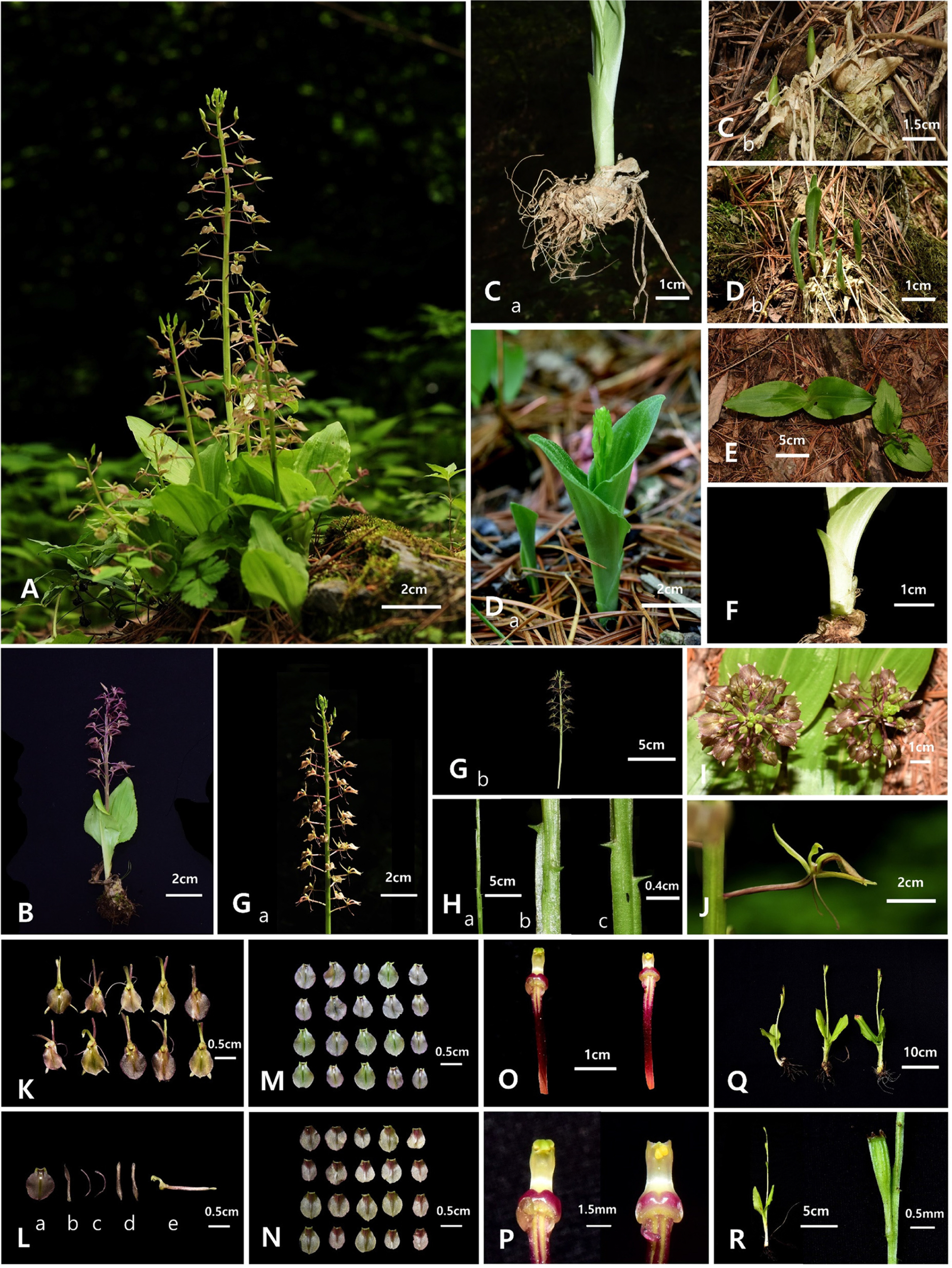
Photographs of Liparis longiracemosa from Korea. A. Habit. B. Plant. C. Pseudobulb. a, pseudobulb showing roots and leaves; b, pseudobulb with the shoot embedded in soil. D. Young plants. a, inflorescence is emerging; b, early stage of leaf development. E. Leaves. F. Petiole. G. Inflorescence. H. Bracts. b and c, various sizes of bracts. I. Top view of inflorescence. J. Lateral view of flower. K. Various views of flowers. L. Structure of flower. a, lip; b, dorsal sepal; c, petals; d, lateral sepals; e, lateral view of column, pedicel, and ovary. M. Front view of lips in various sizes and colors. N. Rear view of lips of various sizes and colors. O. Various views of column, pedicel, and ovary. P. Various views of column and pollinia, Q. Various views of fruiting plants. R. Fruiting plants and capsules.
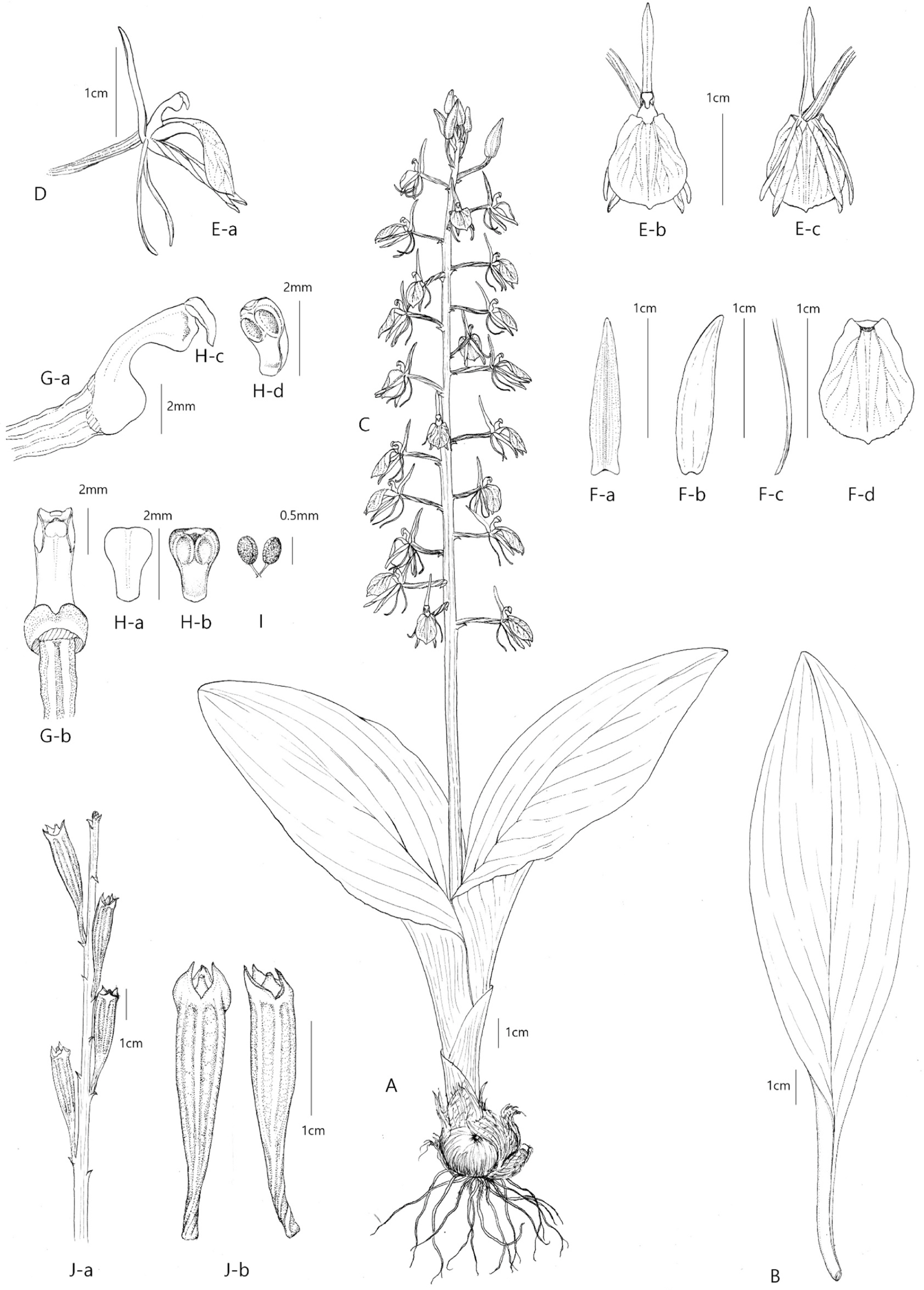
Liparis longiracemosa from Korea. A. Plant. B. Leaf. C. Inflorescence and flowers. D. Pedicel and ovary. E. various views of flower. a, side view of flower; b, front view of flower; c, rear view of flower. F. Structure of flower. a, dorsal sepal; b, lateral sepal; c, petal; d, lip. G. Various views of column. a, side view of column; b, inside view of column. H. Various views of anther cap. a, top view of anther cap; b and d, inside view of anther cap; c, side view of anther cap. I. Pollinia. J. Fruiting plant and capsules. a, fruiting plant; b, various views of capsules.

Photographs of Liparis makinoana from Korea. A. Habit. B. Plant. C. Pseudobulb. a, pseudobulb showing roots and leaves; b, pseudobulb with the shoot embedded in soil. D. Young plants. a, inflorescence is emerging; b, early stage of leaf development. E. Leaves. F. Petiole. G. Inflorescence. H. Bracts. b and c, various sizes of bracts. I. Top view of inflorescence. J. Lateral view of flower. K. Various views of flowers. L. Structure of flower. a, lip; b, dorsal sepal; c, petals; d, lateral sepals; e, lateral view of column, pedicel, and ovary. M. Front view of lips in various sizes and colors. N. Rear view of lips in various sizes and colors. O. Various views of column, pedicel, and ovary. P. Various views of column and pollinia. Q. Various views of fruiting plants. R. Fruiting plants and capsules.

Liparis makinoana from Korea. A. Plant. B. Leaf. C. Inflorescence and flowers. D. Pedicel and ovary. E. Various views of flower. a, side view of flower; b, front view of flower; c, rear view of flower. F. Structure of flower. a, dorsal sepal; b, lateral sepal; c, petal; d, lip. G. Various views of column. a, side view of column; b, inside view of column. H. Various views of anther cap. a, top view of anther cap; b and d, inside view of anther cap; c, side view of anther cap. I. Pollinia. J. Fruiting plant and capsules. a, fruiting plant; b, various views of capsules.

Neotype specimen of Liparis makinoana. Specimen designated as neotype of L. makinoana by Efimov (2010); plant on the left with an arrow mark designated as the type plant of L. makinoana by Tsutsumi et al. (2019).
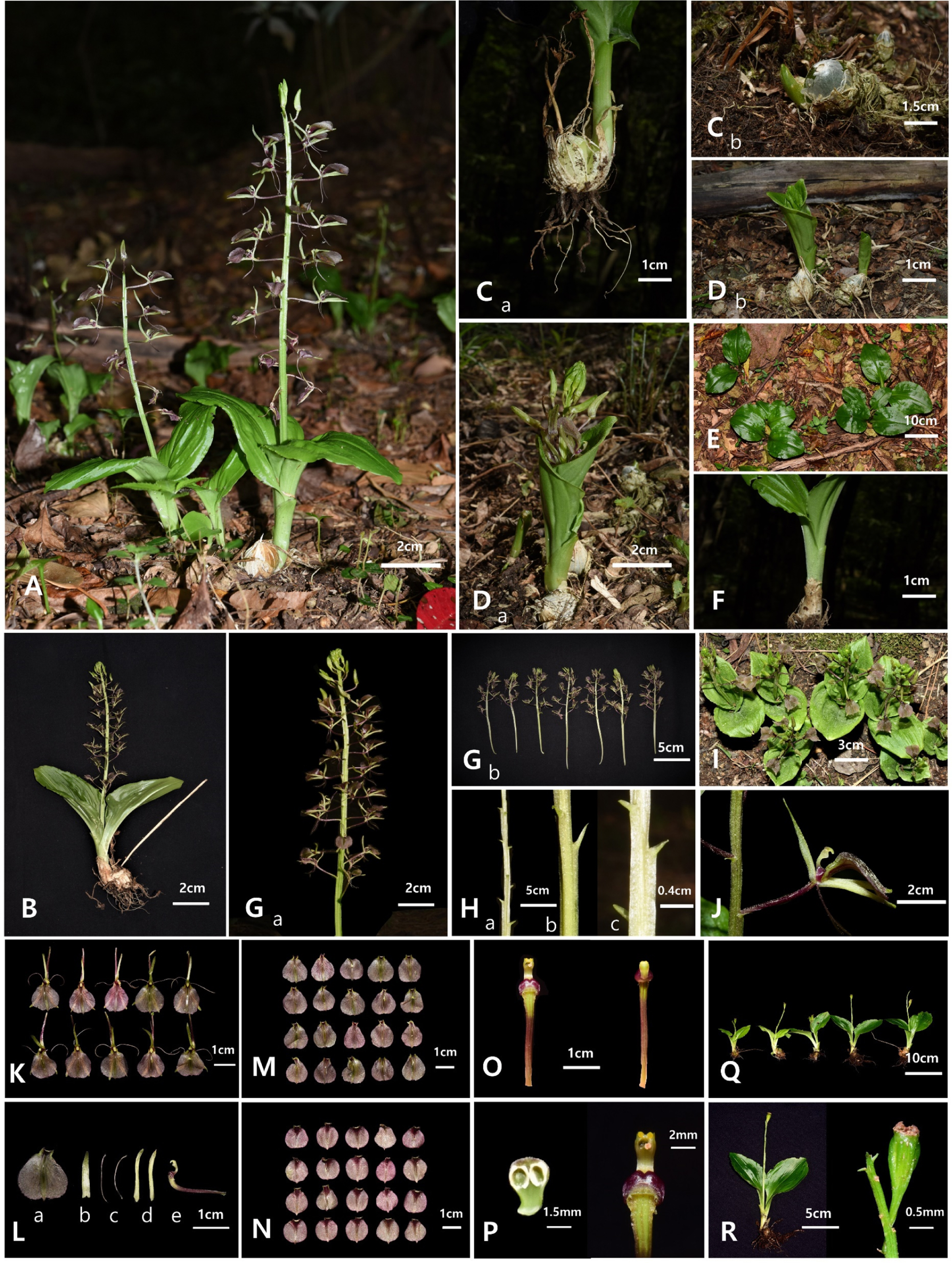
Photographs of Liparis suzumushi from Korea. A. Habit. B. Plant. C. Pseudobulb. a, pseudobulb showing roots and leaves; b, pseudobulb with the shoot embedded in soil. D. Young plants. a, inflorescence is emerging; b, early stage of leaf development. E. Leaves. F. Petiole. G. Inflorescence. H. Bracts. b and c, various sizes of bracts. I. Top view of inflorescence. J. Lateral view of flower. K. Various views of flowers. L. Structure of flower. a, lip; b, dorsal sepal; c, petals; d, lateral sepals; e, lateral view of column, pedicel, and ovary. M. Front view of lips in various sizes and colors. N. Rear view of lips in various sizes and colors. O. Various views of column, pedicel, and ovary. P. Various views of column and pollinia. Q. Various views of fruiting plants. R. Fruiting plants and capsules.
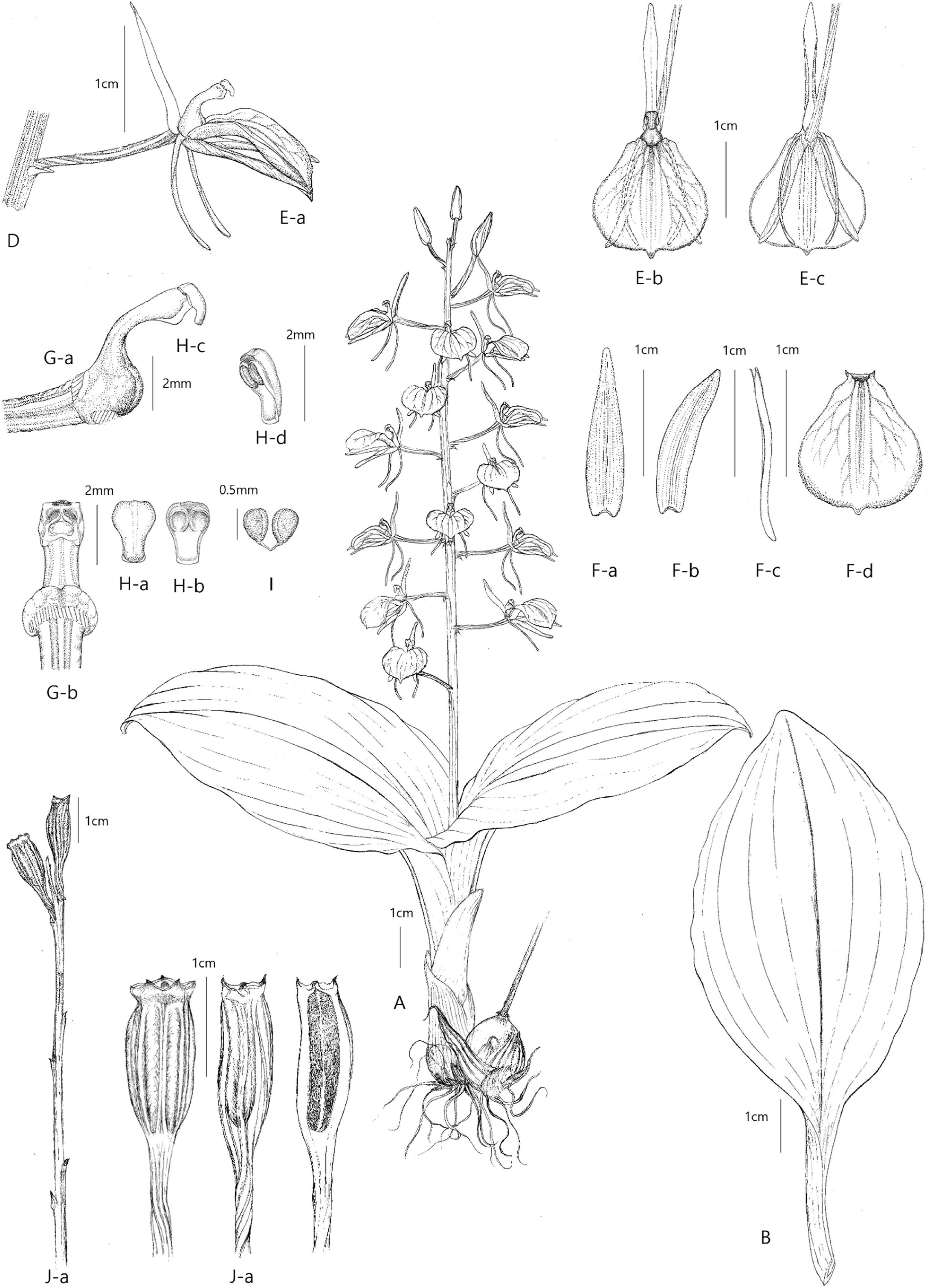
Liparis suzumushi from Korea. A. Plant. B. Leaf. C. Inflorescence and flowers. D. Pedicel and ovary. E. Various views of flower. a, side view of flower; b, front view of flower; c, rear view of flower. F. Structure of flower. a, dorsal sepal; b, lateral sepal; c, petal; d, lip. G. Various views of column. a, side view of column; b, inside view of column. H. Various views of anther cap. a, top view of anther cap; b and d, inside view of anther cap; c, side view of anther cap. I. Pollinia. J. Fruiting plant and capsules. a, fruiting plant; b, various views of capsules.
A key to identify the Liparis makinoana complex and its related taxa in Korea
1. Leaves broadly ovate or ovate-elliptic, margins undulate; anther cap apex apiculate
2. Inflorescence 15–35 cm long, 8–30-flowered; lip 9– 12 mm long, 6–9 mm wide ··········· L. koreojaponica
2. Inflorescence 7–25 cm long, 4–20-flowered; lip 6– 7 mm long, 4–5 mm wide ······················ L. kumokiri
1. Leaves oblanceolate to ovate-elliptic or suborbicular to broadly ovate-elliptic, margins entire; anther cap apex beaked
3. Flowering in May to early June; distributed on Jejudo Island; leaves suborbicular to broadly ovate-elliptic; lip broadly obovate, 13–17 mm long, 10–15 mm wide ·· ·································································· L. suzumushi
3. Flowering in June to July; distributed inland; leaves oblanceolate to ovate-elliptic; lip obovate or narrowly obovate, 7–12 mm long, 4–9 mm wide
4. Distributed in central regions, 60–900 m; lip obovate, 8–12 mm long, 5–9 mm wide; anther cap apex slightly obtuse ······················· L. makinoana
4. Distributed in Baekdu-daegan, 550–1,500 m; lip narrowly obovate, 7–10 mm long, 4–7 mm wide; anther cap apex acute ················ L. longiracemosa
Acknowledgements
This study was supported by the Korea National Arboretum (KNA1-2-43, 23-1). We sincerely thank Dr. Tomohisa Yukawa from the National Museum of Science for providing us with two holotype specimens for the study. We also thank Heesoo Kim for drawing the illustrations and Byung-Gyu Yoo for reporting the locations.
Notes
CONFLICTS OF INTEREST
The authors declare that there are no conflicts of interest.

